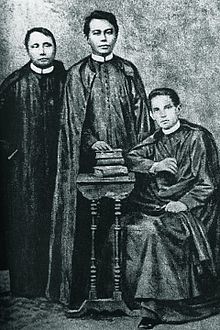Secularization movement in the Philippines

The secularization movement in the
Background
During the
They are two key groups among the Catholic clergy in the Philippines in relation to the secularization movement.[1]
- Seculars (seculares) – Clergymen who are not affiliated with a religious order. They are mostly native Filipinos. At the time they are referred to as indios with the term Filipino exclusive to Spaniards born in the Philippines (insulares).[2] Parish works is usually reserved to seculars but the Spanish colonial government in the Philippines had to deal with the issue that there are virtually no Spaniard seculars due to the low immigration rate of Spaniards to the Philippines due to its distance from Spain and its weak economy.[3]
- Regulars (regulares) – Clergymen who are part of an established order. They are mostly Spaniards.
The secularization movement encouraged the assignment of native Filipino priests to head parishes. The movement was met with opposition from the Spanish friars who are regulars due to its negative effects to their political authority and influence in the Philippine islands.[4] Some religious regulars justified their opposition to give native priests more responsibility with racist reasoning, and that the natives are allegedly not suitable for priesthood to begin with. They were also concerned that the secularization process might lead to secession of the island colony from Spain. Native priests previously played a role in the uprisings in Mexico and Peru.[5]
History
Spanish-sanctioned secularization
Charles III of Spain in 1759 instituted a policy which aimed to subject the Catholic Church to the Spanish monarchy. The religious orders resisted such moves in contrast to the seculars who report to bishops appointed by the monarchy.[5]
The secularization movement began in the 1770s. Following the expulsion of the Jesuits in 1768 from all of the
In 1787, the colonial government in the Philippines petitioned for Charles III to put an end to secularization policy.[6] The Spanish government revoked its secularization policy in 1826, despite the Holy See's position of discouragement against the permanence of a religious order in governing a parish. However, the Rome (modern-day Vatican) or the Pope had no absolute power over Catholic clergy in the Philippines. The Pope's decision affecting the Philippines had to be approved by the Spanish government and religious orders in the Philippines still wielded influence over the colonial government and could override Rome (modern-day Vatican).[5]
Native-led secularization movement

The secularization movement continued to grew heading to the early 19th century. One of the native priests which led the movement in that period was
However, upon the suppression of the Jesuits, the Recollect Order moving to the parishes once owned by Jesuits, surrendered their parishes to local Filipino diocesans or secular clergy, temporarily assuaging Filipino yearnings.[7]
The Jesuits returned to the Philippines in 1859 displacing many
Execution of the Gomburza and aftermath

The movement culminated in 1872 with the execution of the Gomburza, which consisted of three native priests namely Burgos himself, Mariano Gomez, and Jacinto Zamora. Being prominent figures of the secularization movement, they were accused of being involved in the 1872 Cavite mutiny.
Furthermore the Governor General who was a
The Gomburza was later regarded as
At the peak of the Philippine Revolution, more than 800 of the 967 parishes and missions were under the control of religious orders. More than 400 of the regulars were captured and many others were killed during the revolution.[6]
The start of the
The secularization movement also led to the establishment of the
References
- ^ a b c d Umali, Justin (February 17, 2020). "How the Death of Gomburza Led to a Wholly Filipino Church". Esquiremag. Retrieved September 9, 2021.
- ^ Dawoodbhoy, Zahara (February 24, 2016). "The Politics of Religion in the Philippines". The Asia Foundation. Asia Foundation. Retrieved September 9, 2021.
- ISSN 0021-910X.
- ^ a b c d e Pasion, Francis Kristoffer (February 16, 2021). "Remembering the GOMBURZA: In Anticipation of the 150th Anniversary of their Martyrdom in 2022". National Historical Commission of the Philippines. Retrieved September 9, 2021.
- ^ a b c d e f Uckung, Peter Jaynul (September 6, 2012). "The Secularization Issue was an international Issue". National Historical Commission of the Philippines. Retrieved September 9, 2021.
- ^ a b c d e f "IV. A Filipino clergy emerges". 500 Years of Christianity in the Philippines. Retrieved September 9, 2021.
- ^ a b c Escalante, Rene (May 12, 2020). "WATCH: GOMBURZA an NHCP Documentary" (video). youtube.com. National Historical Commission of the Philippines.

